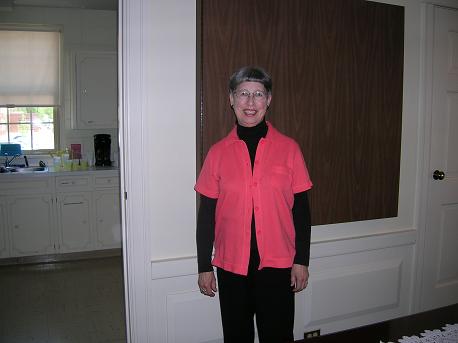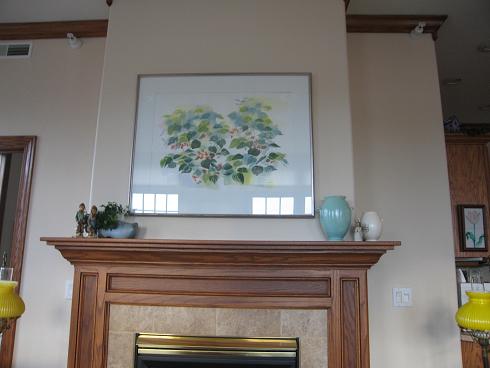by Joline De Jong
I asked my friend, Joline De Jong to write this because I like the way she incorporates her love of art in all aspects of her life.
My name is Joline (De Boer) De Jong. I was born in 1933 in the heart of the Great Depression1. My parents, Central College graduates whose grandparents immigrated2 here from the Netherlands, were high school teachers of history, English and Latin.
As a child I had no idea that I would become an artist. Indeed I knew no artists personally except for my elementary school art teacher. When we moved to a smaller community3, there were no art teachers for grades six through twelve.
My thrifty4 mother designed and sewed attractive dresses for my sister and me. As I grew older I enjoyed becoming the family’s seamstress5. This experience in designing and crafting6 garments7 was the closest I came to an art experience until my graduating class needed an illustrator8 for its yearbook9. I took up the challenge10.
At Central College I intended to major in biology, but I took a beginning11 art class out of curiosity12. When I discovered that drawing pictures of my dissections of frogs13 was what I enjoyed most about biology, I switched14 to an art major.
My husband John’s first job in American history was at Arizona State University15. After completion of my graduate work there, we returned in 1968 with our three children to teach at Central College. Art education, modern art history, introduction to drawing and painting, plus some studio courses16 in pastel17 and watercolor18 became my responsibility19. My own art work has been primarily in these two media20. While I continue to make landscape paintings21, I have noticed that the process of making aesthetic22 choices spills over into other aspects of my life23. Here are a few examples:
An admiration for the work of Frank Lloyd Wright24 led us to design our own house in 1970, which was built on a wooded hillside near the Des Moines River outside Pella. Wright was interested in creating houses which fit into their setting and which encouraged an openness within the house as well as an interchange25 between the interior of the house and its exterior surroundings in nature. Therefore we designed an open floor plan for its public rooms, which meant eliminating interior walls except around bedrooms and bathrooms. Wide sliding glass doors open the house to a deck which overlooks26 the woods. Large plants inside the house contribute to the harmony27 with the outdoors. The interior of the house has been kept neutral28 in color with white walls, to focus attention on the artwork29 on the walls.
I also like to make aesthetic choices for such things as the food I prepare for guests. Besides being nutritious and flavorful30, it is important to me that the food is attractive in color and texture31. The same principles of design which I taught my students continue to guide the choices I make in life. A creative problem may be solved by the manipulation32 of one or more elements of art such as line, color, form, texture and contrast33. A non-painting example of some of these: The addition of a scarf with a striking34 black and white pattern which a friend brought me from China added variety , contrast, and emphasis to an all black shirt and slacks ensemble35.
Music has played an important role in our lives since my husband and I became acquainted while on a choir tour36 as college undergraduates. We have continued to sing in choral groups through the years. While music is a different art form from visual art they share many parallels37 in construction38 and presentation39. The ancient Greeks used a principle called “The Golden Mean40,” which gave balance and order to their aesthetic choices. Perhaps all cultures have something similar to which their people pattern their lives. Do you have some such organizing principle41 which you use?
Notes:
1. The Great Depression: a period in U.S. History (about 1928-38) when the economy was not strong, and many people were unemployed (美国经济大萧条,约于1928至1938年期间美国经济不景气,很多人失业).
2. immigrated here from the Netherlands: moved to the U.S. from the Netherlands (从荷兰移民到美国).
3. community: 社区
4. thrifty: using money carefully and wisely (节俭的).
5. seamstress: a person who sews clothing (裁缝).
6. crafting: making something using a special skill, especially with your hands (制作).
7. garments: items of clothing (服装).
8. illustrator: one who prepares drawings or paintings for some sort of book (插图画家).
9. yearbook: a book dealing with a specific academic class and its activities (年鉴).
10. challenge: an activity which requires close attention and application of sound judgment (艰巨任务).
11. beginning: being the start or first part of something (起始的,入门的).
12. curiosity: 好奇心
13. dissections of frogs: processes involved in cutting frogs so that the internal organs of the body can be studied and easily seen (解剖).
14. switched: changed from one thing to another (转换,更换).
15. Arizona State University: 亚利桑那州立大学
16. studio courses: art topics that are taught in an art studio rather than outside.
17. pastel: 粉笔(画)
18. watercolor: 水彩(画)
19. responsibility: what is expected of one as a job or duty (职责).
20. media: particular materials that artists use for creating their work (艺术家创作时所用的材料).
21. landscape paintings: 风景画
22. esthetic: of a pleasing effect or appreciation of beauty or art (美学的,审美的).
23. spills over into other aspects of my life: spreads into other parts of my life (扩展到我生活的其他方面).
24. Frank Lloyd Wright: the name of an outstanding 20th century architect in the U.S. (法兰克洛伊莱特,20世纪美国著名的建筑师).
25. interchange: put each of two things in the place of the other (交互,互换).
26. overlooks: has a view of something, usually from above (俯视).
27. harmony: the pleasant effect made by different things that form an attractive whole (和谐).
28. neutral: not brightly colored, or not standing out as unusual in color (色彩不鲜艳的).
29. artwork: some type of artistic product (艺术品).
30. nutritious and flavorful: containing nourishing or healthful food items and having a strong pleasant taste (有营养的和味道好的).
31. texture: the way that a particular type of food feels in your mouth (口感,质感).
32. manipulation: 操纵
33. elements of art such as line, color, form, texture and contrast: 艺术的各种因素如线条,颜色,形式,质感和对比。
34. striking: attractive in an unusual way that is easy to notice (引人注目的,吸引人的).
35. ensemble: a set of clothes that are worn together (一整套服装).
36. choir tour: a trip taken by a group of singers (合唱团的巡回演出).
37. parallels: ways in which separate things or people are similar to each other (相似的手法,共同点).
38. construction: building, producing or making some physical item by putting them together (构筑方式).
39. presentation: the placing of something, such as a work of art, so that it has the most appealing appearance (展示方式).
40. The Golden Mean: a principle of the Greek culture which sought for moderation or the most balance or middle-point between extremes (中庸之道).
41. organizing principle: a system which allows one to place things or ideas or perspectives in order in one’s life (使井然有序的原则).


